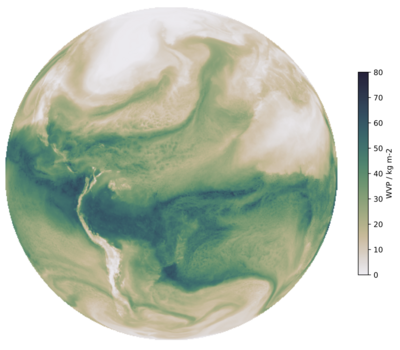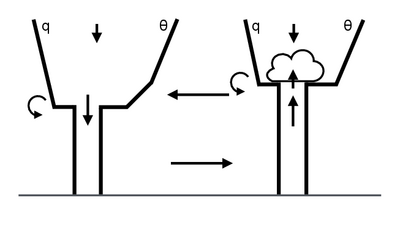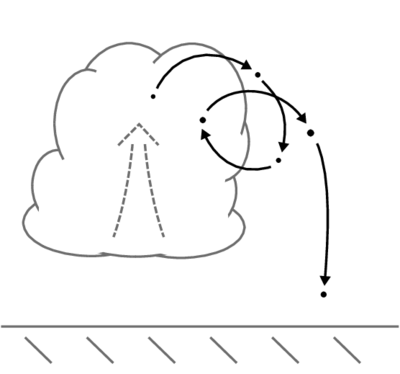Science interests

In global storm-resolving models that resolve convection explicitly instead of parameterizing it, microphysical processes are now fundamentally linked to their controlling factors, i.e., the circulation. While in conventional climate models the convective parameterization is one of the main sources of uncertainties (and a popular tuning parameter), this role might be passed on to the microphysical parameterization in global storm-resolving models. In an ongoing project we investigate how microphysical choices affect the albedo, radiative fluxes, and the heat budget in more general.
Global storm-resolving models come along with methodological challenges: because of the large cost of the simulations, new ways to explore sensitivities using only very short runs are needed. In this study, we refine a method based on moisture space, where observational limitations can be taken into account and carried over to the simulated moisture space thereby allowing for a fair comparison between short-term simulations and limited observations. Applying this method to airborne lidar measurements, we illustrate the fragility of simulated cloudiness at kilometer-scale resolution and how a model's ability to properly capture the water vapor distribution does not need to translate into an adequate representation of shallow cumulus clouds that live at the tail of the water vapor distribution.

By simplifying a physical system to its fundamental processes, conceptual models help us to investigate and understand more complex behavior. To understand how radiative cooling induces shallow circulations, we develop a conceptual model of the lower part of the tropical troposphere. According to our theory, flows may be driven as much by differential longwave cooling in the lower troposphere, as by surface temperature gradients arising from differences in near-surface wind speeds or insolation changes. In other words, the radiative effects of water vapor in the lower troposphere may play a very active role in the coupled dynamics of lower, tropical troposphere. In a follow-up study, we extend the framework to the moist convective boundary layer of the trade wind regime. We show that shallow circulations driven by radiative differences suppress convection in the descending branch and enhance it in the ascending branch, which resembles shallow cloud patterns.

Understanding precipitation remains one of the major challenges in numerical weather prediction as well as climate modeling. To investigate warm rain microphysical processes on a particle-based level, we have developed a Lagrangian drop (LD) model to simulate raindrop growth in shallow cumulus. The LD model is part of the UCLA-LES and represents all relevant rain microphysical processes such as evaporation, accretion and selfcollection among LDs as well as dynamical effects such as sedimentation and inertia. Sensitivities of the LD model are small compared to the uncertainties in the assumptions of commonly used bulk rain microphysics schemes.
We have applied the LD model to study the development of the raindrop size distribution in shallow cumulus clouds and show that the shape of the raindrop size distribution depends on the stage of the lifecycle of the cloud. The study suggests that two-moment schemes with a diagnostic parameterization of the shape parameter, i.e., a local closure in space and time, are not sufficient, especially when being applied across different cloud regimes. One way to overcome this issue may be a prognostic shape parameter, i.e., a triple-moment warm-rain microphysics scheme.
Using the LD model, we have also investigated the growth process of raindrops and the role of recirculation of raindrops for the formation of precipitation in shallow cumulus. Recirculation of raindrops is found to be common in shallow cumulus, especially for those raindrops that contribute to surface precipitation. The fraction of surface precipitation that is attributed to recirculating raindrops differs from cloud to cloud but can be as large as 50 %. This implies that simple conceptual models of raindrop growth that neglect the effect of recirculation disregard a substantial portion of raindrop growth in shallow cumulus.
Curriculum Vitae
Group leader
since 2019 Max Planck Institute for Meteorology and University of Hamburg
Head of the CLICCS joint working group on the drivers of tropical circulation
Postdoc
2015 - 2018 Max Planck Institute for Meteorology
Dr. rer. nat.
2011 - 2015 Max Planck Institute for Meteorology and IMPRS-ESM
Thesis title: Cloud structures and rain formation in the atmospheric boundary layer
University
2009 - 2011 University of Hamburg (Meteorology - M.Sc.)
2009 The University Centre in Svalbard (exchange student)
2006 - 2009 University of Hamburg (Meteorology - B.Sc.)
Publications
Pithan, F., A. K. Naumann, and M. Maturilli: Too cold, too saturated? Evaluating climate models at the gateway to the Arctic, in review.
2024
Fons, E., A. K. Naumann, D. Neubauer, T. Lang, and U. Lohmann: Investigating the sign of stratocumulus adjustments to aerosols in the global storm-resolving model ICON, Atmos. Chem. Phys., 24, 8653–8675, doi:10.5194/acp-24-8653-2024, 2024.
2023
George, G., B. Stevens, S. Bony, R. Vogel, and A. K. Naumann (2023): Widespread shallow mesoscale circulations observed in the trades, Nat. Geosci., 16, 584–589, doi:10.1038/s41561-023-01215-1.
Hohenegger, C., and 59 co-authors (incl. A. K. Naumann) (2023): ICON-Sapphire: simulating the components of the Earth System and their interactions at kilometer and subkilometer scales, Geosci. Model Dev., 16, 779–811, doi.org/10.5194/gmd-16-779-2023.
Lang, T., A. K. Naumann, S. Buehler, B. Stevens, H. Schmidt, and F. Aemisegger (2023): Sources of uncertainty in mid-tropospheric tropical humidity in global storm-resolving simulations, J. Adv. Model. Earth Syst., 15, e2022MS003443, doi.org/10.1029/2022MS003443.
Radtke, J., R. Vogel, F. Ament, and A. K. Naumann: Spatial organisation affects the pathway to precipitation in simulated trade-wind convection, Geophys. Res. Lett., 50(20), e2023GL103579, doi.org/10.1029/2023GL103579.
2022
Radtke, J., A. K. Naumann, M. Hagen, and F. Ament (2022): The relationship between precipitation and its spatial organisation in the trades observed during EUREC4A, Q. J. R. Meteorol. Soc., 148, 1913–1928, doi:10.1002/qj.4284.
2021
Jung, H., A. K. Naumann and B. Stevens (2021): Convective self-aggregation in a mean flow, Atmos. Chem. Phys., 21, 10337–10345, doi:10.5194/acp-21-10337-2021.
Lang, T., A. K. Naumann, B. Stevens and S. Buehler (2021): Tropical free-tropospheric humidity differences and their effect on the clear-sky radiation budget in global storm-resolving models, J. Adv. Model. Earth Syst.,13, e2021MS002514, doi:10.1029/2021MS002514.
Stevens, B., S. Bony, D. Farrell and 290 co-authors (incl. A. K. Naumann) (2021): EUREC4A, Earth Syst. Sci. Data, 13, 4067–4119, doi:10.5194/essd-13-4067-2021.
2020
Fiedler, S., T. Crueger, R. D'Agostino, K. Peters, T. Becker, D. Leutwyler, L. Paccini, J. Burdanowitz, S. A. Bühler, A. U. Cortes, T. Dauhut, D. Dommenget, K. Fraedrich, L. Jungandreas, N. Maher, A. K. Naumann, M. Rugenstein, M. Sakradzija, H. Schmidt, F. Sielmann, C. Stephan, C. Timmreck, X. Zhu and B. Stevens (2020): Simulated tropical precipitation assessed across three major phases of the coupled model intercomparison project (CMIP), Mon. Weather Rev., 148(9), 3653-3680, doi:10.1175/MWR-D-19-0404.1.
Naumann, A. K., and C. Kiemle (2020): The vertical structure and spatial variability of lower-tropospheric water vapor and clouds in the trades, Atmos. Chem. Phys., 20, 6129–6145, doi:10.5194/acp-20-6129-2020.
Stevens, B., S. Bony, H. Brogniez, L. Hentgen, C. Hohenegger, C. Kiemle, T. S. L'Ecuyer, A. K. Naumann, H. Schulz, P. A. Siebesma, J. Vial, D. M. Winker, and P. Zuidema (2020): Sugar, gravel, fish, and flowers -- Mesoscale cloud patterns in the tradewinds, Q. J. Royal Meteorol. Soc., 146, 141-152, doi: 10.1002/qj.3662.
Stevens, B., and 56 co-authors (incl. A. K. Naumann) (2020): Large-eddy and storm resolving models for climate prediction -- The added value for clouds and precipitation, J. Meteor. Soc. Japan, 98(2), 395-435, doi:10.2151/jmsj. 2020-021.
2019
Klingebiel, M., V. Ghate, A. K. Naumann, F. Ditas, M. Pöhlker, C. Pöhlker, K. Kandler, H. Konow, and B. Stevens (2019): Remote sensing of sea salt aerosol below trade wind clouds, J. Atmos. Sci., 76(5), 1189-1202, doi:10.1175/JAS-D-18-0139.1.
Naumann, A. K., B. Stevens, and C. Hohenegger (2019): A moist conceptual model for the boundary layer structure and radiatively driven shallow circulations in the trades, J. Atmos. Sci., 76(5), 1289-1306, doi:10.1175/JAS-D-18-0226.1.
Vial, J., R. Vogel, S. Bony, B. Stevens, D. M. Winker, X. Cai, C. Hohenegger, A. K. Naumann, and H. Brogniez (2019): A new look at the daily cycle of tradewind cumuli, J. Adv. Model. Earth Syst., 11(10), 3148-3166, doi: 10.1029/2019MS001746.
2018
Crueger, T., M. A. Giorgetta, R. Brokopf, M. Esch, S. Fiedler, C. Hohenegger, L. Kornblueh, T. Mauritsen, C. Nam, A. K. Naumann, K. Peters, S. Rast, E. Roeckner, H. Schmidt, M. Sakradzija, J. Vial, R. Vogel, and B. Stevens (2018): ICON-A, the atmosphere component of the ICON Earth System Model. Part II: Model evaluation, J. Adv. Model. Earth Syst., 10(7), 1638–1662, doi:10.1029/2017MS001233.
2017
Bellon, G., O. Reitebuch, and A. K. Naumann (2017): Shallow circulations: relevance and strategies for satellite observation, Surv. Geophys., 38(6), 1509-1528, doi:10.1007/s10712-017-9442-2.
Naumann, A. K., B. Stevens, C. Hohenegger, and J. P. Mellado (2017): A conceptual model of a shallow circulation induced by low-level radiative cooling, J. Atmos. Sci., 74(10), 3129-3144, doi:10.1175/JAS-D-17-0030.1.
Rauser, F., M. Alqadi, S. Arowolo, N. Baker, J. Bedard, E. Behrens, N. Dogulu, L. Domingues, A. Frassoni, J. Keller, S. Kirkpatrick, G. Langendijk, M. Mirsafa, S. Mohammad, A. K. Naumann, M. Osman, K. Reed, M. Rothmüller, V. Schemann, A. Singh, S. Sonntag, F. Tummon, D. Victor, M. Villafuerte, J. Walawender, and M. Zaroug (2017): Earth system science frontiers: An early career perspective, Bull. Amer. Meteor. Soc., 98(6), 1120-1127, doi: 10.1175/BAMS-D-16-0025.1.
2016 and earlier
Naumann, A. K. and A. Seifert (2016): Recirculation and growth of raindrops in simulated shallow cumulus, J. Adv. Model. Earth Syst., 08(2), 520-537, doi:10.1002/2016MS000631.
Naumann, A. K. and A. Seifert (2016): Evolution of the shape of the raindrop size distribution in simulated shallow cumulus, J. Atmos. Sci., 73(6), 2279-2297, doi:10.1175/JAS-D-15-0263.1.
Naumann, A. K. and A. Seifert (2015): A Lagrangian drop model to study warm rain microphysical processes in shallow cumulus, J. Adv. Model. Earth Syst., 7(3), 1136-1154, doi:10.1002/2015MS000456.
Naumann, A. K., A. Seifert, and J. P. Mellado (2013): A refined statistical cloud closure using double-Gaussian probability density functions, Geosci. Model Dev., 6, 1641-1657, doi:10.5194/gmd-6-1641-2013.
Naumann, A. K., D. Notz, L. Håvik, and A. Sirevaag (2012): Laboratory study of initial sea-ice growth: properties of grease ice and nilas, The Cryosphere, 6, 729-741, doi:10.5194/tc-6-729-2012.
Naumann, A. K. (2015): Cloud structures and rain formation in the atmospheric boundary layer. PhD thesis, University of Hamburg.
Naumann, A. K. (2011): Physikalische Prozesse der Meereisentwickung in offenem Wasser. Master thesis, University of Hamburg.
